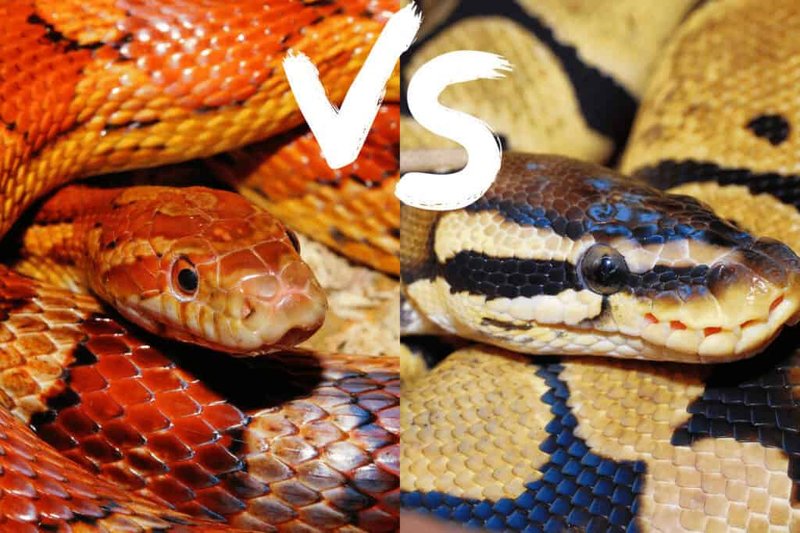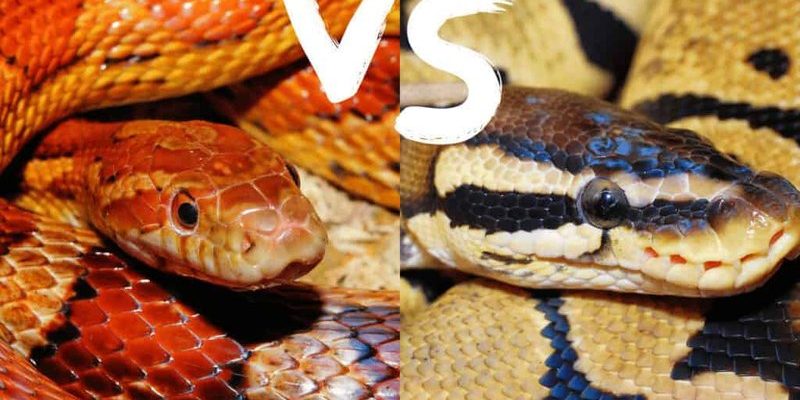
Let’s dive into the characteristics, needs, and quirks of these two reptiles. By the end, you’ll have a clearer idea of which snake fits better with your lifestyle and preferences.
Appearance: What Do They Look Like?
Both the Corn Snake and the Ball Python are visually stunning, but they boast different styles.
Corn Snakes typically have a vibrant array of colors, ranging from bright oranges and yellows to deep reds. Their distinctive patterns—often resembling the scales of a corn cob—make them stand out. They usually grow to about 3 to 5 feet long, so they’re manageable in size but still eye-catching in a terrarium.
On the other hand, Ball Pythons are often dark brown or black with beautiful yellow and gold patterns. These little guys are a bit chunkier than Corn Snakes, averaging 3 to 5 feet in length but can weigh more due to their robust bodies. Their calm colors and unique patterns give them a more understated elegance, like a cozy blanket on a chilly night.
Temperament: Which Snake is Friendlier?
If you’re looking for a friendly companion, you might wonder which snake is more approachable.
Generally speaking, Corn Snakes are known for their curious and active nature. They are excellent for beginners because they’re often friendly and curious, making them fun to handle. They usually don’t mind being taken out of their habitat and are less prone to stress, which is a bonus for new snake owners.
In contrast, Ball Pythons are known for being a bit more shy and reserved. They tend to prefer staying in their hideouts. However, once they feel comfortable, they can be just as affectionate. Many Ball Pythons enjoy being held and will even curl up in your arms, making them a favorite for those who enjoy a more relaxed bonding experience.
Care Needs: What Do They Require?
Taking care of a snake isn’t just about feeding it. It’s about creating a comfortable home for your scaly friend.
Corn Snakes are relatively easy to care for. They thrive in an enclosure that mimics their natural habitat, which should include a temperature gradient, hiding spots, and a water dish for soaking. Feeding them is straightforward; they usually eat mice or other small rodents, and with proper care, they can live 15-20 years.
Ball Pythons need similar care but have a few additional requirements. They prefer a slightly higher humidity level, so regular misting of their enclosure may be necessary. Like Corn Snakes, they eat small rodents but tend to be a bit pickier, sometimes refusing food if they’re stressed or uncomfortable. With proper care, they can live anywhere from 20 to 30 years, so it’s a long-term commitment!
Feeding Habits: What’s on the Menu?
When it comes to feeding, both snakes have their preferences, but there are some differences to consider.
Corn Snakes usually eat once a week to every two weeks, depending on their age and size. They love a diet of properly sized mice or rats, and some even enjoy the thrill of hunting if you opt for live feeding—but always be cautious. It’s essential to monitor how much they eat to avoid overfeeding, which can lead to health issues.
Ball Pythons, however, can be a bit more finicky. They might refuse food during shedding or if they’re stressed, which can be concerning for new owners. Ball Pythons also typically eat once every week or two, and it’s crucial to offer them the right-sized prey to avoid health complications.
Enclosure Set-Up: What’s Best for Your Snake?
Setting up a cozy home for your snake is essential for their happiness and health.
For a Corn Snake, a 20-gallon tank is usually adequate for a smaller snake, but consider upgrading to a larger enclosure as they grow. Provide plenty of climbing opportunities—like branches or logs—as well as hiding spots to mimic their natural environment. Keep the temperature gradient between 75°F on one end and 85°F on the other, and don’t forget a water bowl that’s big enough for them to soak in.
Ball Pythons, on the other hand, may require a larger enclosure, starting at around 30 gallons, especially as they grow. Their habitat should include hiding spots, a warm basking area, and a cooler side. Maintaining humidity levels between 50-60% is vital, plus a water bowl that’s deep enough for soaking.
Cost: What Should You Expect?
When bringing a new snake home, the cost factor is one you shouldn’t overlook.
Both Corn Snakes and Ball Pythons are relatively affordable pets, but costs can add up with their care.
Corn Snakes typically range from $50 to $200, depending on their color and morph. However, the expenses don’t stop there. You’ll need to budget for an enclosure, heating, food, and regular vet check-ups. Overall, expect to spend around $300 to $600 in the first year.
Ball Pythons can be a bit pricier, often ranging from $100 to $300 or more, especially for certain morphs. Just like with Corn Snakes, the initial setup and ongoing care are essential to budget. Plan on similar costs of around $300 to $600 for the first year, depending on your choices.
Final Thoughts: Which Snake is Right for You?
Choosing between a Corn Snake and a Ball Python comes down to your preferences and lifestyle. If you enjoy a more active snake that’s curious and friendly, the Corn Snake might be your perfect match. If you prefer a lower-key companion that enjoys curling up with you, then a Ball Python could be the one for you.
Ultimately, both snakes can make wonderful pets with the right care and attention. Remember, whether it’s a splash of color or soothing gentleness you’re after, there’s a snake out there ready to become a part of your family.

